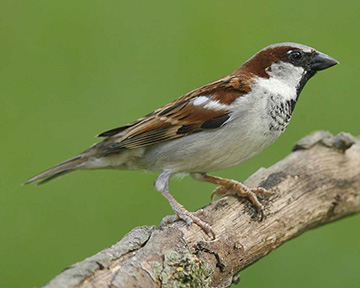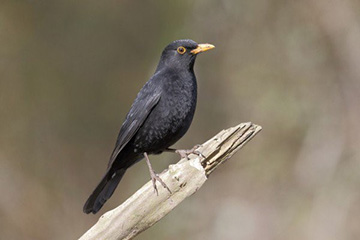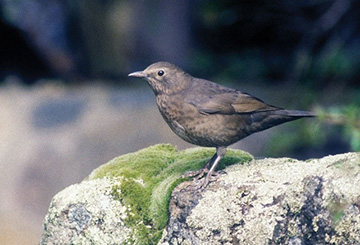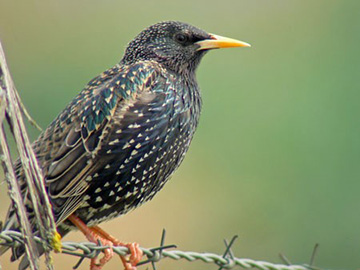My mother always told me that the birds in the back yards of her industrial Lancashire home town were "common as muck". I always felt a little sorry for the feathered detritus, as they had simply achieved successful ways of living within the human habitat and should be commended rather than defamed.
The same could be said of some of the regular birds who live in the Sanctuary Lakes "backyards". They have within a relatively short time become so common that they are almost ignored. So I thought I should put the spotlight on three birds who live all year round not on our lake, ponds, creek, golf course or wetland, but close to us, in our garden and around the house, starting with the most well-known, the ubiquitous House Sparrow.
 House Sparrow Passer domesticus The House Sparrow was introduced into Victoria in 1863. They quickly established themselves around human habitat and cultivated farmland. One reason for the successful establishment of the House Sparrow in Australia and, indeed, all over the world, is its ability to feed on a wide range of foodstuffs. They will eat insects, spiders, berries, seeds, flower buds and more importantly scraps of food discarded by humans. Sparrows are so unconcerned with humans that they are often seen entering food areas in buildings to feed, and even learning to activate automatic doors in order to gain entry.
House Sparrow Passer domesticus The House Sparrow was introduced into Victoria in 1863. They quickly established themselves around human habitat and cultivated farmland. One reason for the successful establishment of the House Sparrow in Australia and, indeed, all over the world, is its ability to feed on a wide range of foodstuffs. They will eat insects, spiders, berries, seeds, flower buds and more importantly scraps of food discarded by humans. Sparrows are so unconcerned with humans that they are often seen entering food areas in buildings to feed, and even learning to activate automatic doors in order to gain entry.
House Sparrows are actually from the smaller finch family, with an average size of 15 cm. The male has a conspicuous grey crown, black face and throat, and dark black and brown upperparts. When breeding the male bill will change from brown to black. The female is slightly paler than the male and lacks the grey crown and black face, instead having a pale buff eye stripe.
House sparrows build untidy grass and stick dome nests lined with feathers, mainly in gaps of buildings, often under eaves, and between and beneath roofing tiles. They also nest in the safety of dense bushes. The female lays between two to six white to pale grey eggs with dark grey and brown spots. They are incubated for 10-14 days. Young fledge after 14-17 days. They have a long breeding season, which can extend from July to April, with peak breeding between September and February. Two or three broods are commonly raised during a season. Males often switch partners between broods but remain loyal to nest sites, which are aggressively defended from other males and smaller native species.
 Male Blackbird Turdus merula House Sparrows' tendency to displace native birds from nest sites causes some people to resent them. But House Sparrows, with their capacity to live so intimately with us, are just beneficiaries of humans own success at displacing nature.
Male Blackbird Turdus merula House Sparrows' tendency to displace native birds from nest sites causes some people to resent them. But House Sparrows, with their capacity to live so intimately with us, are just beneficiaries of humans own success at displacing nature.
Another European immigrant brought into Melbourne during the 1850-60s was the Common Blackbird (Turdus Merula).
The Common Blackbird is a medium sized bird and stands at around 27 cm. Their stance has a cockiness to it, with an almost skipping stride. The male is the 'black' bird, with deep orange to yellow bill, a narrow yellow eye-ring and dark legs. Or as Bottom in Shakespeare's A Midsummer Night's Dream, described him "The Woosell cocke, so blacke of hew, With Orenge-tawny bill".
 Female Blackbird The female sadly is a very plain brown bird, with some streaks or mottling, and has a dark bill and legs.
Female Blackbird The female sadly is a very plain brown bird, with some streaks or mottling, and has a dark bill and legs.
Like the House Sparrow the Blackbird has the ability to consume most things. They will eat insects, earthworms, snails, spiders and a range of seeds and fruit. It mainly forages on the ground, probing and scratching at leaf litter, lawns and soil.
Often seen in the spring, around Sanctuary Lake gardens is the male blackbird attracting the female with an unusual courtship display consisting of oblique runs combined with head-bowing movements, an open beak, and a "strangled" low song. The female remains motionless possibly stunned by the adoration. Blackbirds are monogamous and an established pair will usually stay together as long as they both survive.
The Common Blackbird builds a cup-shaped nest of dried grass, bound with mud, and lined with fine grasses. It is usually placed in a dense shrub or low bush, but they will sometimes use tree hollows.
Breeding season is September to January. The female will lay 3 to 5 eggs with incubation taking about 14 days. Two weeks later the chicks will leave the nest.
Blackbirds are sedentary in their habitat, and we now see them in our gardens all the year round. They have learnt to benefit from our food scraps and their jaunty familiarity is always amusing.
Sing a song of sixpence a pocketful of Rye
Four and Twenty Blackbirds baked in a Pie
 Starling Sturnus Vulgarus The Starling is a medium-sized passerine bird and stands about 20 cm. It has a glossy black plumage with a glossy metallic sheen, which is speckled with white at certain times of year. The legs are pink and the bill is black in winter and yellow in summer;
Starling Sturnus Vulgarus The Starling is a medium-sized passerine bird and stands about 20 cm. It has a glossy black plumage with a glossy metallic sheen, which is speckled with white at certain times of year. The legs are pink and the bill is black in winter and yellow in summer;
Introduced to Melbourne in 1857 to consume insect pests of farm crops, early settlers looked forward to their arrival, believing that common starlings were also important for the pollination of Flax, then a major agricultural product. Not only were they successful as insect exterminators and pollinators, but they breed extremely fast and by the 1920s were considered agricultural pests.
Starlings are social birds, form flocks that move, feed and roost together. On the ground, they walk jauntily or run rather than hop like many other birds.
During breeding season September to January, Starlings break up into pairs. The nest is an untidy cup of grasses, leaves, twigs and items of human rubbish. Nest sites are any type of hollow, such as tree hollows and house roof voids. The birds are aggressive when competing for nesting sites and readily drive out native species. The pale blue eggs are incubated by both sexes who also raise the young birds. Often two broods are raised in a season.
There are many similarities with these feathered mid-Victorian immigrants. Thanks to predator Cats, Foxes and Hawks they have not yet reached pest status in our neighbourhood, but we can assist in a natural control, by planting more Australian native trees and plants in our "backyards".